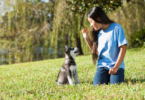Did you know that a four-month-old puppy can hold its bladder for up to five hours? This surprising fact highlights the importance of understanding your puppy's capabilities when it comes to potty training. Proper training is crucial for both your puppy's well-being and the integrity of your home.
Early training can prevent costly damage to your home and reduce the risk of house soiling, a leading reason why dogs end up in shelters. According to experts like Mary Burch, Ph.D., crate training and a consistent schedule are essential for successful potty training. By establishing a routine and using positive reinforcement, you can help your puppy learn good habits.
Consistency and supervision are key. Puppies need to go outside frequently, especially after meals, playtime, and naps. Avoid punishment, as it can lead to fear and aggression. Instead, use positive reinforcement with treats and praise to encourage good behavior.
By following these guidelines, you can raise a well-trained puppy that brings joy and companionship to your family.
Understanding the Basics of Puppy Potty Training
Early training is essential for helping your dog learn proper potty habits. Puppies, like human children, need guidance to understand where and when it's appropriate to go. Without early training, bad habits can form, leading to accidents and potential long-term issues.
Why Early Training Matters
Puppies can only control their bladders for a limited time, roughly equal to their age in months. For example, a 4-month-old puppy can typically hold its bladder for about 4 hours. This limited control makes early training crucial to prevent accidents and establish good habits.
Recognizing Your Puppy's Signals
Puppies often signal their need to go outside through specific behaviors. Sniffing, circling, and scratching at the door are common signs. Whining or restlessness can also indicate that your puppy needs to be taken outside quickly. Recognizing these signals early can save time and help maintain a clean home.
Experts emphasize that responding promptly to these signals is vital. By doing so, you reinforce proper potty habits and help your puppy learn faster. Consistency and quick action are key to successful training.
Creating a Consistent Housebreaking Schedule
Establishing a regular routine is key to successful housebreaking. A well-structured schedule helps your dog learn when it's time to go outside, reducing the chance of accidents.
Start by taking your dog outside immediately after meals, naps, and play sessions. This is when they are most likely to need to go. For example, after breakfast, lunch, dinner, and any playtime, take them to the designated area.
Research shows that puppies should be taken out every hour, and after every meal. As they grow, you can gradually increase the time between trips. For instance, a 3-month-old puppy can typically hold their bladder for about 4 hours.
A consistent schedule helps your dog develop an internal clock, making it easier for them to learn. Professional trainers recommend setting specific times for feeding, play, and rest to maintain a predictable routine.
Using a leash and consistent cues during each trip outside can also aid in the training process. This helps your dog associate the command with the action, making the learning process smoother.
Puppy Potty Training Advice: Essential Methods and Tools
When it comes to housebreaking your dog, using the right methods and tools can make all the difference. Two of the most effective approaches are crate training and the use of puppy pads, combined with positive reinforcement. These techniques help establish good habits and reduce accidents.
Effective Use of Crate Training
A crate is a valuable tool for potty training. Dogs naturally avoid soiling their sleeping area, so a correctly sized crate helps prevent accidents. Start by introducing the crate gradually, allowing your dog to explore it at their own pace. Begin with short periods and increase the time as they become comfortable. This method not only aids in potty training but also provides a safe space for your dog.
Utilizing Puppy Pads and Positive Reinforcement
Puppy pads are useful for indoor training, especially in situations where outdoor access is limited. Place the pads in a designated area and reward your dog when they use them correctly. Positive reinforcement with treats and praise encourages good behavior. However, rely too much on pads can delay outdoor training, so use them wisely.
Consistency and patience are key. By combining crate training with puppy pads and positive reinforcement, you can help your dog learn faster and reduce the likelihood of accidents. Remember, every dog is different, so adjust your approach as needed to best suit your pet.
Troubleshooting Common Training Challenges
Every dog owner faces challenges during potty training. Recognizing these issues early and addressing them constructively can make a big difference.
Identifying Issues Early
One common problem is repeated soiling in the same spot. This often happens because dogs are attracted to their own scent. Another issue is crate soiling, which can signal that your dog is being left in the crate for too long. Experts recommend checking for signs like sniffing or circling, which indicate your dog needs to go outside.
Handling Accidents Without Punishment
Stay calm if your dog has an accident. Scolding can create fear and make training harder. Instead, clean the area thoroughly with an enzymatic cleaner to remove the scent. This helps prevent your dog from returning to the same spot. Reward your dog for going outside correctly to reinforce good behavior.
When to Consult a Professional
If accidents keep happening despite consistent training, it may be time to seek help. A veterinarian can check for health issues like urinary infections that might be causing the problem. A professional trainer can also offer personalized advice to overcome training challenges. Remember, patience and consistency are key to successful potty training.
Adapting Training to Your Environment
Every home is unique, and your puppy's potty training should fit seamlessly into your living situation. Whether you live in a spacious house with a yard or a cozy apartment, consistency is key to successful training. Let’s explore how to adapt potty training methods to your environment.
Indoor versus Outdoor Strategies
For homes with yards, create a designated outdoor potty area. Take your puppy there after meals, naps, and playtime. If you live in an apartment, consider using puppy pads or indoor dog bathrooms. These tools help maintain consistency when outdoor access is limited.
Indoor training requires supervision. Use a leash indoors to monitor your puppy’s movements and quickly respond to signals like sniffing or circling. Reward your puppy immediately after they use the pad correctly to reinforce good habits.
Managing Weather and Space Limitations
Weather can impact your puppy’s willingness to go outside. On rainy or snowy days, use indoor potty pads or a dog bathroom. For small spaces, ensure the potty area is easily accessible and free from distractions.
Acclimate your puppy to different weather conditions gradually. Start with short exposure to wind or rain and reward calm behavior. This helps your puppy associate outdoor trips with positive experiences, regardless of the weather.
Flexibility is crucial. If you can’t take your puppy outside, rely on indoor tools. Consistency in routine, whether indoors or outdoors, helps your puppy understand where it’s appropriate to go potty.
Bringing It All Together: Steps Towards a Well-Trained Puppy
Consistency and positive reinforcement are the cornerstones of successful housebreaking. By combining early training, a structured schedule, and effective methods, you can guide your dog toward good habits. Remember, every dog is unique, so it's important to adapt your approach as needed.
Start by taking your dog outside every hour, especially after meals and playtime. Use a leash to help them focus and reward good behavior immediately. If accidents happen, clean the area thoroughly to prevent repeat incidents. Stay calm and patient, as scolding can hinder progress.
Monitor your dog's progress and adjust routines as necessary. Even if setbacks occur, revisiting these steps will lead to success. If challenges persist, consult a professional for personalized guidance. With persistence, every dog can become well-trained, bringing joy and companionship to your family.











Leave a Comment